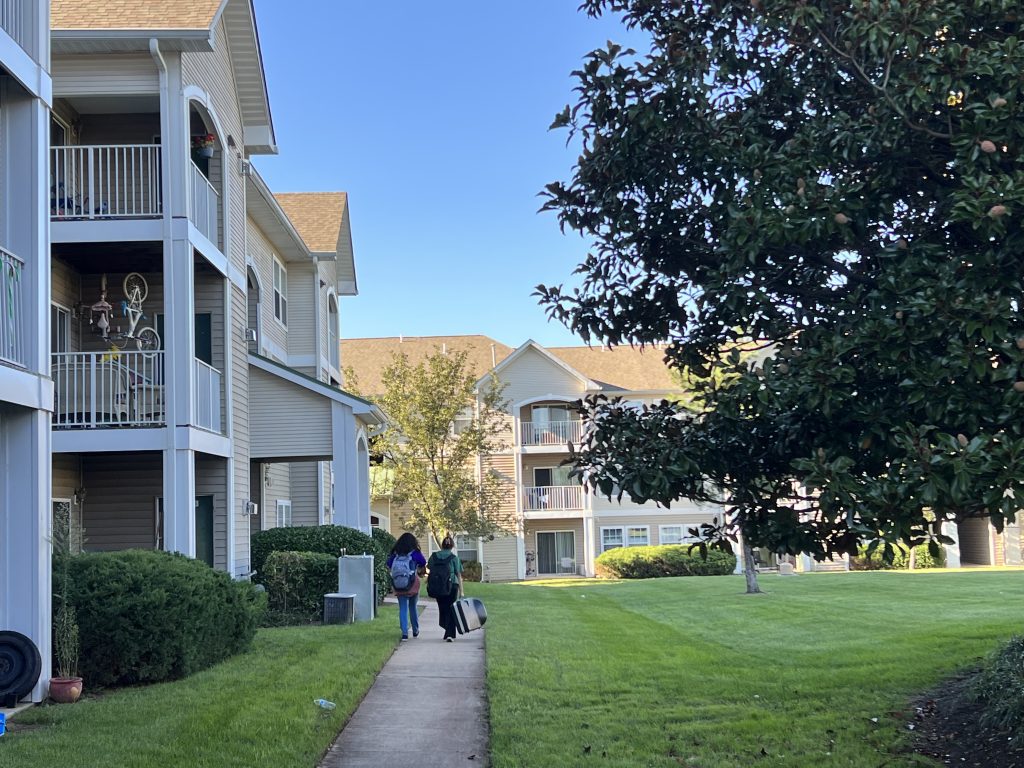
The Fields at Cascades. Photo by Brandon Duong
On June 1, *David woke up to find that during the night, someone had taped a notice to his door. It told him his rent was going to be $150 higher, starting the next month.
“This rent increase is being initiated as a result of the most recent United States Department of Housing and Urban Development (HUD) publication of rental guidelines which have authorized the increase of rent amounts based upon an increase of the average median income for this area,” the notice read.
Although rent increases aren’t uncommon in affordable housing developments like the one David lives in, what is surprising is that his rent was raised in the middle of his lease.
“We weren’t expecting a rent increase. For the cost of living we have, we weren’t prepared,” David says through an interpreter.
David and his family live at the Fields at Cascades, a 320-unit affordable housing development in Loudoun County, Virginia, that was built using the Low-Income Housing Tax Credit (LIHTC) program. This development is set to lose its affordability requirements entirely in 2025. Both David, who works at a restaurant, and his wife work full-time, but even with their combined incomes the family struggles to pay all their bills. “I have three young kids and it’s really hard to be able to afford rent. My wife and I both work and we have to work in shifts so that we don’t have to pay for babysitters,” David says.

Photo by Brandon Duong
David isn’t the only one facing mid-lease rent increases. A few miles away, tenants reported experiencing the same issue at another LIHTC property called Potomac Station. “Until the month of June, I paid $1,884,” says *Edward, a tenant living at the 150-plus unit property. “In July, I started paying $2,082. Apart from that I pay $50 for laundry, plus water, electricity and gas.” Edward emphasizes that even though the $182 increase in rent happened in July, his apartment’s lease doesn’t end until December. Shelterforce reached out to CRC Companies—the owners of Potomac Station—and Jair Lynch—the owners of the Fields at Cascades—but neither returned our request for comment.
Edward lives with his nephew, his wife, and a woman who shares the rent with them. He’s a maintenance worker at a nearby mall while his wife works in a restaurant. He says that the rent increase has put a heavy burden on the household. He no longer can afford to visit the doctor for his hypertension and high cholesterol. “I felt really bad because we haven’t had any raises where we’re working and I wasn’t sure how we’re going to pay this increase,” he says.
Sofia Saiyed, an organizer with New Virginia Majority, says the two apartment complexes in Loudoun County where David and Edward live house nearly 500 residents, but there may be other LIHTC developments in the area where mid-lease rent increases have also occurred.
As a result, “we have heard of people who were deciding to leave the apartments, also people who are just deciding to relocate out of the area in general,” Saiyed says.
Typically, one of the main benefits of a lease is knowing you have your rent locked in for the duration of the contract. But the mid-lease rent hikes in these LIHTC properties are possible because of something called an escalator clause. These are provisions in leases that allow affordable housing providers to raise rents if HUD income limits change, even if those changes occur in the middle of the lease. Under the rules of the LIHTC program, escalator clauses are allowed.
Incomes Limits Rose Sharply
In April, HUD published its updated income limits for 2022. These income limits determine both eligibility for LIHTC units and the maximum rent that an owner can charge a LIHTC tenant. HUD calculates these limits by applying an inflation rate measure to the most recent American Community Survey data (in this case 2019). Given historically high inflation rates, 99 percent of U.S. counties saw a substantial increase in income limits (and therefore allowable rent) this year, even though income growth has not kept up with growth in expenses for most lower income households. Nearly 60 percent of renters who participated in a new Freddie Mac survey reported increases in rent within the last 12 months, with 1 in 3 renters witnessing increases of 10 percent or more. Meanwhile, only 38 percent of renters surveyed say they’ve received a raise at their jobs.
HUD does put a cap on how much income limits can increase in a year, and this year, it changed how that cap was calculated, possibly to moderate the effect of such a large jump. Even with that change, however, the increase is substantial. In Loudoun County, Virginia, where Edward and David live, the income limits increased by 10.1 percent since last year.
Communities of color are feeling a disproportionate impact of inflation. According to a new poll by NPR/Robert Wood Johnson Foundation/Harvard T.H. Chan School of Public Health, 58 percent of Black and Native American families reported not having enough emergency savings to cover at least one month of their expenses, compared to 53 percent of Latino adults and 36 percent of white adults. The hardships inflicted by this recent increase in inflation are exacerbated by unexpected mid-lease rent increases.
HUD Distances Itself from Rent Increases
Amid high inflation, housing providers may feel they need to adjust rents to cope with increased costs of operations. However, raising rents in the middle of a tenant’s lease with only 30 days’ notice levies a tremendous hardship on already financially precarious households. The tension between these two realities was reflected this year on the data portal where the new income limits are housed.
HUD published a note on that portal when it released the new income limits in April 2022 clarifying that HUD does not administer the LIHTC program and “has no control over how LIHTC rents are set and has not required or suggested rent increases.” However, it added, “HUD continues to encourage property owners to exercise compassion with respect to tenants affected by the COVID-19 pandemic and would be surprised that an owner would be so out of step with the moment in which we are living to raise rents at this time.”
It seems that statement might have been too strong for some LIHTC property owners. Sometime between June and August 2022, according to the Internet Archive, the last sentence of that note was changed to read instead: “To the extent that owners increase rents, given the purpose of the LIHTC is to keep units affordable, HUD encourages owners to increase them no more than what is needed to keep pace with rising costs and recognize that to promote housing stability, incremental increases are easier for tenants to absorb than sudden significant increases.”
Who Regulates Escalator Clauses?
There’s very little information on how prevalent escalator clauses are in LIHTC developments across the country. State housing agencies—which are tasked with regulating state LIHTC programs—rarely, if ever, make rules overseeing the use of escalator clauses. Qualified Allocation Plans, which are documents that lay out states’ and localities’ priorities in distributing low-income housing tax credits, rarely penalize their use.
Can this be fixed in retrospect? Whether a state agency has the authority to impose new regulations on existing projects, “depends on a variety of factors,” says Marcos Segura, a staff attorney at the National Housing Law Project. “These procedural factors vary from state to state, so it’s hard to offer a hard and fast rule on state agency authority to regulate rent increases at existing LIHTC projects.”
However, Segura says, there may be another way.
“The authority of a state legislature to regulate LIHTC rents is more straightforward,” he says. If the legislature passes such a regulation, the only question would be whether it is constitutional. “Regulations limiting rent increase frequency and amount do not prohibit an owner from charging max LIHTC rent (only the pace at which an owner arrives at that ceiling) and thus will not have a significant economic effect on LIHTC owners, at least in theory,” says Segura. “This makes it likely that such a regulation will survive constitutional scrutiny.”
That’s How a Lease Works
In July, Saiyed and residents met with the owners of Fields at Cascades, and the owners pledged that moving forward they would only increase rents once a year. However, Saiyed stressed the need for increased oversight over these types of mid-lease rent hikes, especially in affordable housing developments.
“Whenever a tenant signs a lease with a landlord, the assumption is that that lease [and the rent amount in it] is valid for the term that they signed it for,” says Saiyed. “That’s kind of, across the board, the basic assumption of how a lease works.”
“It feels very unjust that the only places where this is allowed are in these affordable housing complexes, because the population that is least able to handle an unexpected midterm rent increase is the one . . . being subjected to them,” she continues. “We really need better protections for tenants at affordable housing properties. Legal protections at the state level, at the federal level, to prevent this kind of surprise rent increase in the middle of the term.”
*David and Edward are not the tenants’ real names. Shelterforce agreed to conceal the tenants’ identities because of concerns about potential retaliation from their landlords.




THe system of financing permanent affordable housing is broken. We need to build new financing tools now.
Two years later and this is still happening across the country.
I have friends that have just been served mid lease with a 9.49% rent hike due to new AMI reports being released in April.
There is something wrong with this system especially since the developers already know that they are bringing low income tenants just to hike up the rent mid-lease.
This seems to be an unscrupulous and dubious business practice and I am not sure here but I feel there is a need for a class action lawsuit. Against who? The system that allows for these convoluted contracts that don’t show clearly that they have explicitly expressed the right to raise the rent mid-lease. If this was made more clear to tenants I am sure most would not agree to sign.
You are soo, so right in your statement. I just received notice that my rent will increase by $157 starting in September. My lease expires April 2025. I’m a senior and recently unemployed and the struggle to pay my bills is already heavy. I live in a tax credit community with a Community Manager who just doesn’t listen to or like the tenants or anything customer service related. Tenants of tax credit communities are the least likely to financially adjust to such rent hikes when we barely make enough for market rents since we qualify for tax credit units. Who’s responsible for this? I have a long time until my lease expires and can’t see where any job I’ve been applying for can afford the rent and utilities. Heavily looking to move out of state to secure affordable housing because the stress of it all is daunting. I can’t break my lease because at this age, I can’t afford for my rental credit to be screwed up. Yet, that will happen because I’ve now been priced out of my home and roof over my head. Why is this happening and does anyone in our government care?